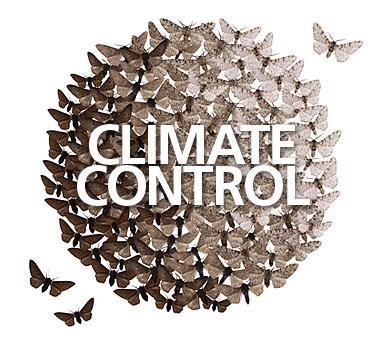Exhibition review: Climate Control @ Manchester Museum
June 17, 2016

When I saw that Manchester Museum was holding an exhibition about climate change, entitled Climate Control, I was relieved to see an initiative that would combat the apathy and indifference so many feel towards the issue of global warming.
The exhibition is split into the past and the future, holding that, while the past can’t be changed, it can and should inform our efforts to shape the future of our planet. The past section is dense with artefacts, for the most part relating to types of wildlife (including an impressively massive taxidermy polar bear) that could be lost if climate change continues to worsen. Exhibits of peppered moths show how insects adapted to sooty environments during the industrial revolution, and back again after the Clean Air Act 1956 – a powerful symbol for the notion that change is possible. For kids, the exhibition provides a visually engaging way of explaining what fossil fuels are, how they have been utilised and what the consequent climate change might mean for the world.
However, in my opinion, the exhibition fell short in what I’d hope it might do: make the urgency of climate change real for visitors who feel either powerless in the face of or detached from the process of climate change. Having each visitor add a black sticker to a white wall to represent how each individual’s actions contribute to a gradual build up of emissions, alongside now-and-then pictures tracking how glaciers have melted due to global temperatures rising, were nice ideas but, for me, didn’t communicate the urgency of a level of climate change that scientists and scholars consider a potential threat to the whole human race – not just to arctic wildlife.
There was neither reference to the fact that in 2016 global temperatures are repeatedly smashing records for the century-long period we have accurate data for, nor the ‘endlessly and ominously tumbling records for temperature and extreme weather events’ shown here and here. The Life in a Changing Climate section briefly mentions examples of climate change’s effects on humans already, such as how slum dwellers from Malda in Bangladesh are more vulnerable to storms and having their homes flooded. However, I felt the photos and brief comments failed to really humanise the experiences of people living through the impact of climate change right now. And that’s not to mention the absence of any allusion to the grossly unequal situation in which it is poorest countries who contribute the least to global warming that are the most affected. To mention just one statistic, the average Bangladeshi uses 300 watts of power per year compared to the 12000 watts consumed annually by the average American.
It’s telling that in boxes showing visitors’ opinions at the end of the exhibition, the most full were ‘If I knew what to do, I would do more of it’ and ‘I don’t think my actions will make a difference’. It is evident that a sense of powerlessness dominates public opinion. It’s great for a museum to focus so strongly on visitor participation, and I feel that what the boxes show could inform future ideas for campaigns and exhibitions – which could, for example, focus more specifically on the real difference individuals can make through innovation and coming together, and on impressive examples of state-led dedication to the replacement of fossil fuels and nuclear power with sustainable sources of energy.
We need to understand that climate change is a state of emergency, but we also need to feel that there is hope. This exhibition is doing a good job at starting a public conversation, but I think that to create the necessary shifts in public consciousness on this issue we need to harness the urgency and hope evident if we look close enough.
Filed under: Art & Photography, Politics
Tagged with: climate change, Climate Control, exhibition, families, kids, Manchester Museum, Science



Comments